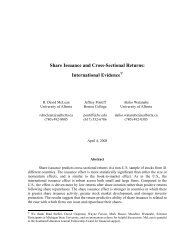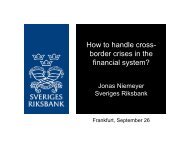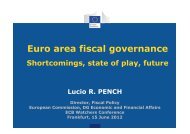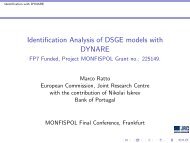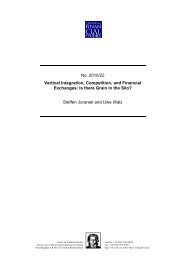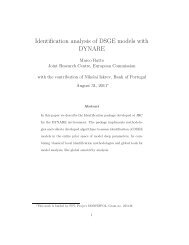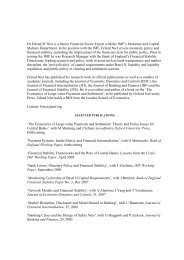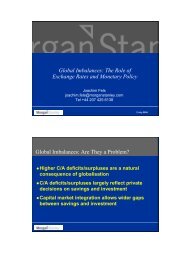Forecasting and Policy Making (Paper) - Center for Financial Studies
Forecasting and Policy Making (Paper) - Center for Financial Studies
Forecasting and Policy Making (Paper) - Center for Financial Studies
Create successful ePaper yourself
Turn your PDF publications into a flip-book with our unique Google optimized e-Paper software.
where it is assumed that the policy maker observes potential output ¯yt <strong>and</strong> sets the y ∗ t accordingly.<br />
Contrary to the simple rules discussed above, the optimal control policy implies a direct interest<br />
rate response to all state variables, including zt, which st<strong>and</strong>s <strong>for</strong> many variables that affect output<br />
<strong>and</strong> inflation. The <strong>for</strong>ecast-based rule incorporates an indirect response to all state variables via the<br />
inflation <strong>and</strong> output <strong>for</strong>ecasts, but the functional <strong>for</strong>m of this rule imposes additional restrictions on the<br />
coefficients relative to the optimal control policy. The optimal control coefficients ˜ φπ, ˜ φy <strong>and</strong> ˜ φz are<br />
nonlinear functions of the structural model <strong>and</strong> loss function parameters (κ,γ,α,σ,δ,θ1,θ2,θ3,β,λ).<br />
These coefficients are generally different from the response parameters in the simple rules, that is<br />
(φπ,φy) <strong>and</strong> (φπ,h,φy,k). Forecasts of future inflation <strong>and</strong> output deviations from the central bank’s<br />
targets—conditional on the central bank’s model <strong>and</strong> in<strong>for</strong>mation set—are used in optimizing the path<br />
of the central bank interest rate.<br />
No central bank has publicly announced that it strictly implements an optimal control policy <strong>and</strong><br />
communicated the preference <strong>and</strong> model parameters needed <strong>for</strong> the policy calculation. Svensson<br />
(1999, 2003) has proposed to mimic the optimal control policy by pursuing a so-called <strong>for</strong>ecast tar-<br />
geting rule. This rule is expressed in <strong>for</strong>ecasts of the target variables output <strong>and</strong> inflation, rather than<br />
directly implementable interest rate prescriptions. In his terminology the loss function with inflation<br />
<strong>and</strong> the output gap in equation (1) is referred to as flexible inflation targeting. He breaks the opti-<br />
mization problem in two steps. First, he derives the first-order conditions with respect to output <strong>and</strong><br />
inflation conditional on the Phillips curve, equation (4), that determines the economic tradeoff be-<br />
tween these two target variables. In the second step, the other model equations are used to derive the<br />
interest rate setting. This interest rate setting is equivalent to the optimal control policy defined by<br />
equation (7). Svensson (2003) shows that the optimality condition corresponds to,<br />
E[πt+j+1 − π ∗ |It] = λ<br />
βκ (βE[(yt+j+1 − y ∗ t+j+1) − (yt+j − y ∗ t+j)|It]), j ≥ 0. (8)<br />
<strong>for</strong> the case when zt is exogenous. This relationship between output <strong>and</strong> inflation <strong>for</strong>ecasts provides an<br />
implicit definition of the optimal control policy. With regard to its practical implementation, Svensson<br />
(2003) recommends that ”the central bank staff construct the ”feasible” set of <strong>for</strong>ecasts <strong>and</strong> instru-<br />
ment plans. The decision-making body ... then selects the combination of <strong>for</strong>ecasts that ”look best”<br />
...., the best compromise between stabilizing the inflation gap <strong>and</strong> the output gap. ” This recommenda-<br />
tion is similar but not identical to another often-used description of inflation <strong>for</strong>ecast targeting, which<br />
states that central banks should set policy such that the implied inflation <strong>for</strong>ecast is equal to the central<br />
bank’s target at some given, constant horizon.<br />
Having presented several different approaches to the use of <strong>for</strong>ecasts in policy design, namely sim-<br />
ple outcome-based rules, simple <strong>for</strong>ecast-based rules, optimal control policies <strong>and</strong> <strong>for</strong>ecast targeting<br />
rules, we close by noting an equivalence result that is obtained under restrictive conditions. Specifi-<br />
cally, if the parameters γ <strong>and</strong> δ are set to zero, the other endogenous variable(s) denoted by zt do not<br />
affect inflation or output. Thus, the optimal control policy takes the <strong>for</strong>m of a simple outcome-based<br />
16



